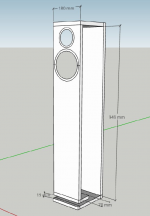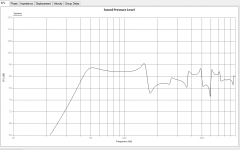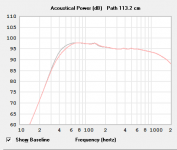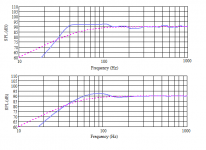Usually adding stuffing in MLTL from closed end to driver and maybe lining two of the walls with felt gets rid of boomy bass.
FWIW, for my acoustically large, non tapered MLTLs I sim +3-6 dB at tuning when using a typical basic T/S BR program, recommending no damping beyond lining the top, back, one side down to below the vent with 1" acoustic fiberglass insulation [OC 703] since I know from experience that a MLTL will be much too over damped in most cases, with worst case scenario requiring a bit more damping and/or only needing to 'critically' damp the vent to remove any audible 'ringing'.
Indeed, when folks used MJK's MathCad software's simmed recommended amount of polyfil, the folks that did update me/us on their final 'as built' system more often than not said they had to pull some, to nearly all, of it back out, so finally just began suggesting folks 'stuff to taste'.
GM
This is what happens when you go bigger and taller.
With a basic reflex, not a proper MLTL. Please see my response to X re peaking, etc., so we'll have to 'agree to disagree' since even if it does happen with some drivers, the minor amount of damping deals with them and if for some reason a vented alignment actually has too much bass [a very rare occurrence, especially with smaller drivers], then the tried n'true tweak 'stuff a sock in it' normally solves the problem.
GM
Hi Jonathan,
I should always proof read my post, but I don't always, especially after a camping night when we didn't sleep much! Some family member having trouble with the police in China... long story short, young kid got scared, all fine now!
Yes, 18x18x95 will be great. Making it taller or bigger will unbalance the whole thing, and make it sound boomy. Very un-natural.
Your vent dimensions are perfect and thanks for picking up my mistake... it is 7cm long... not 0.7cm. Damn beer!
My sim had the driver at 42cm (centre point of the driver) from the top.
If you place the driver at 20cm from the top, you get this -2dB ripple between 200 and 350Hz. If you are ok with that, then go ahead and place the driver higher up.
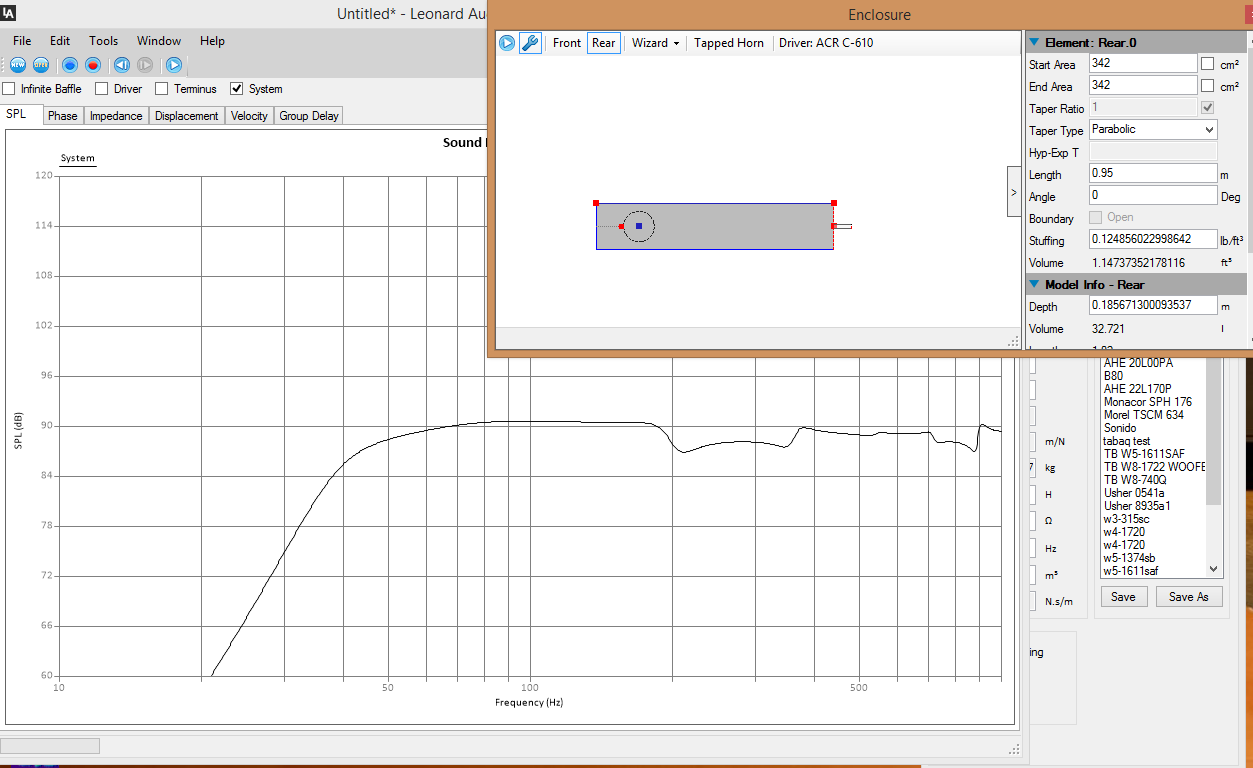
If your tweeter has a closed back, it will be fine. If you have to make a box for it, you'll have to adjust dimension a little to compensate.
As X mentioned, you may or may not need a BSC.
Placing the enclosure up on the wall will give it a bass boost, and you might not need it. If you prefer the extra imaging from the enclosures off the wall behind them, then you might consider a BSC to bring the top down a bit. All will be according to your taste.
Hopefully all this is correct as there were a few beers involved again tonight!
This is it, rendered as discussed. Driver center is placed 20cm from the top. And tweeter face is rendered here. Actual cutout should be smaller. Do I need to make the enclosure taller?
Also, I don't know if this tweeter is sealed or not.
acr 9kh - Google Search
I am thinking I can put the tweeter on top: open baffle or U-baffle, or inside the enclosure, with a dagger. What do you guys think?
If I understand correctly, crossover frequency plays a part in determining center to center (CTC distance). I am looking to cross somewhere between 3000-6000Hz depending on how high and how well the woofer reaches.
Oh BTW I've placed an order for the woofers, and have ordered a Dayton UMM-6 that a friend will bring from the States. Thanks guys for nudging me in the right direction.
Attachments
Last edited:
ACR really needs to update their website.
I would contact them and ask if it is sealed or not. If it is, just mount as is. If not, you will have to build a small chamber behind it, nothing too big.
As for the XO and CTC, with a bezel that large, I wouldn't worry too much... you won't be able to get so close to the woofer anyway!
Cool to see that you got the ball rolling!
I would contact them and ask if it is sealed or not. If it is, just mount as is. If not, you will have to build a small chamber behind it, nothing too big.
As for the XO and CTC, with a bezel that large, I wouldn't worry too much... you won't be able to get so close to the woofer anyway!
Cool to see that you got the ball rolling!
Do I need to make the enclosure taller?
I am thinking I can put the tweeter on top: open baffle or U-baffle, or inside the enclosure, with a dagger. What do you guys think?
If I understand correctly, crossover frequency plays a part in determining center to center (CTC distance). I am looking to cross somewhere between 3000-6000Hz depending on how high and how well the woofer reaches.
Thanks guys for nudging me in the right direction.
You're welcome!
Normally, barring any speaker max height limitations, the tweeter is placed at the [average, if > 1] listening ear height [Lp], so what is it?
Correct, ideally it needs to be < a 1/4 WL of the XO point away [~34400 cm/4/Hz], but history has shown that this goal only needs to be its perceived height at the [average] [Lp], so often can be pretty far apart on the baffle or 'focused' to this [average] point when the components are quite large, such as huge PA/cinema systems.
As you can see then, at 3-6 kHz the ideal c-t-c spacing even at 3 kHz is impractically small, but back up far enough from the physical minimum dictated by the driver sizes and it's doable in a reasonable size room when typical cone/dome drivers are used; big horns like I prefer, not so much.
GM
It's called ACR 9kh. ACR is an Indonesian brand, I've always read that they were associated with Fostex back in the day, and they are the OEM manufacturer for big brands. Most recently, they are known internationally for their SB Acoustics line. I want to know how their lower end line hold up against mid-low level international brandsWhat tweeter are you using? In general, most teeeters are sealed to make installation easy and to prevent any chance of woofer movement from blowing out the tweeter diaphragm.
Well I've contacted them for a number of times asking for information and heard nothing from them. It seems to me the main core of their business is PA speakers, so that section of the website is quite well-maintained.ACR really needs to update their website.
I would contact them and ask if it is sealed or not. If it is, just mount as is. If not, you will have to build a small chamber behind it, nothing too big.
As for the XO and CTC, with a bezel that large, I wouldn't worry too much... you won't be able to get so close to the woofer anyway!
Cool to see that you got the ball rolling!
Thanks GM. I agree, I always pay attention to tweeter height. Depending on the chair, when I sit my ears are at 110-120cm height. As drawn, the tweeter center is at 90.5cm and driver-tweeter border 86cm.You're welcome!
Normally, barring any speaker max height limitations, the tweeter is placed at the [average, if > 1] listening ear height [Lp], so what is it?
Correct, ideally it needs to be < a 1/4 WL of the XO point away [~34400 cm/4/Hz], but history has shown that this goal only needs to be its perceived height at the [average] [Lp], so often can be pretty far apart on the baffle or 'focused' to this [average] point when the components are quite large, such as huge PA/cinema systems.
As you can see then, at 3-6 kHz the ideal c-t-c spacing even at 3 kHz is impractically small, but back up far enough from the physical minimum dictated by the driver sizes and it's doable in a reasonable size room when typical cone/dome drivers are used; big horns like I prefer, not so much.
GM
Now my room is very very small and if I am 'critically' listening, I am only 150cm away from the speaker baffle. Therefore, I am interested to make the tweeter sit at ear level. Any suggestions?
Now my room is very very small and if I am 'critically' listening, I am only 150cm away from the speaker baffle. Therefore, I am interested to make the tweeter sit at ear level. Any suggestions?
If you want to raise the speaker, make a base for it.
Even better if you can fill it with sand.
Thanks GM. I agree, I always pay attention to tweeter height. Depending on the chair, when I sit my ears are at 110-120cm height. As drawn, the tweeter center is at 90.5cm and driver-tweeter border 86cm.
Now my room is very very small and if I am 'critically' listening, I am only 150cm away from the speaker baffle. Therefore, I am interested to make the tweeter sit at ear level. Any suggestions?
You're welcome!
Well, for one thing, the driver, vent should be at a TL's odd harmonics and the most common driver offset is the 3rd harmonic [~0.349], so using an average 115 cm hear height [Lb] and 1.8 cm thick panels, all dims inside [i.d]:
[Lb] @ 3rd harmonic = 115-1.8 = 113.2 cm
height [L] = 113.2/[1-0.349] = 173.886 cm
driver offset [Zd] = 173.886-113.2 = 60.686 cm
vent offset [Zv] @ 4/5th harmonic = 173.886*0.848 = 147.455 cm
Some folks have their own way to calculate the net volume [Vb], hence width x depth [cross sectional area/CSA], but most just use Hornresp's Loudspeaker Wizard [LW] or other software that can design TL/horns to find it, which due to the driver's tiny Vas combined with it's higher than average [Lb] makes for a relatively huge cab [~102.6 L = ~584 cm^2 CSA for example], which in turn 'demands' a large vent area [Av] and since it's generally not a good plan to have an [Av] > driver [Sd], highest tuning winds up being limited to ~40 Hz with just a baffle thickness ~116.9 cm^2 cutout, right at the lowest practical of 56*0.707 = ~39.6 Hz.
Up against a wall, and especially in a corner, it will provide a surprising amount of [mid] bass from such a 'puny' driver.
But you want/need as small as practical, so putting the driver at the 2nd harmonic results in much more 'ripple' in the bandwidth [BW], so will need considerably more damping as the trade-off to smooth it out as much as the larger cab will naturally be:
[Lb] @ 2nd harmonic = 115-1.8 = 113.2 cm
height [L] = 113.2/[1-0.21] = 143.291 cm
driver offset [Zd] = 143.291-113.2 = 30.09 cm
vent offset [Zv] @ 4/5th harmonic = 143.291*0.848 = 121.511 cm
vent area [Av] = 116.9 cm^2 x 1.8 cm long
net volume [Vb] = 17.79 L [Vas] *4 = 71.16 L
WxD [CSA] = 71.16*1000 = 71160/143.291 = 496.612 cm^2
All dims inside [i.d.] and approximate, so some rounding up is fine and damp [stuff] to 'taste' to get the desired 'fast'/tight', etc., in room response.
You can shrink [CSA] if still too big, just understand that the bass is already rolled off somewhat, so any smaller reduces bass output. Shrink it down to your 342 cm^2 and for smoothest roll off ideally need to reduce Av = 70 cm^2.
GM
Looks nothing like that in real life, much less once damped and why I don't use that program. Does look like one of my big vent reflex BLHs before damping though, but construction wise nothing like a MLTL.
Of the ones I've used, MJK's MathCad worksheets does them best overall, but don't have it loaded, so use HR as an acceptable substitute since DB made so many upgrades, refinements.
Blue line = 496.61 cm^2 CSA/116.9 cm^2 vent
Red line = 342 cm^2/70 cm^2 vent
GM
Of the ones I've used, MJK's MathCad worksheets does them best overall, but don't have it loaded, so use HR as an acceptable substitute since DB made so many upgrades, refinements.
Blue line = 496.61 cm^2 CSA/116.9 cm^2 vent
Red line = 342 cm^2/70 cm^2 vent
GM
Attachments
Hi GM and perceval, thank you again for this wealth of information.
So to sum up, I have a couple of options here:
Option one: Driver at ear height at 3rd harmonic
L = 173.886cm | CSA = 584cm2 | Vent = 116.9cm2 cutout only at 4th or 5th harmonic
Option two: Driver at ear height at 2nd harmonic
L = 143.291cm | CSA = 496.612cm2 | Vent = 116.9cm2 x 1.8cm at 4th or(*) 5th harmonic
Option three: Driver at ear height at 2nd harmonic, smaller foot print
L = 143.291cm | CSA = 342cm2 | Vent = 70cm2 x (**) at (***)
The (*) above denotes my further questions:
(*) Placed at either 4th or 5th is okay? Is 5th harmonic = end of the line opposite from driver side?
(**) What is the length of the vent, or is this just with baffle thickness?
(***) Placed also at 4th or 5th harmonic?
Re: the need to make it as small as practical, allow me to ask, is this related to my listening space area? I wager the answer is yes and my room is tiny, at 2.4x2.9m. Thanks again!!
So to sum up, I have a couple of options here:
Option one: Driver at ear height at 3rd harmonic
L = 173.886cm | CSA = 584cm2 | Vent = 116.9cm2 cutout only at 4th or 5th harmonic
Option two: Driver at ear height at 2nd harmonic
L = 143.291cm | CSA = 496.612cm2 | Vent = 116.9cm2 x 1.8cm at 4th or(*) 5th harmonic
Option three: Driver at ear height at 2nd harmonic, smaller foot print
L = 143.291cm | CSA = 342cm2 | Vent = 70cm2 x (**) at (***)
The (*) above denotes my further questions:
(*) Placed at either 4th or 5th is okay? Is 5th harmonic = end of the line opposite from driver side?
(**) What is the length of the vent, or is this just with baffle thickness?
(***) Placed also at 4th or 5th harmonic?
Re: the need to make it as small as practical, allow me to ask, is this related to my listening space area? I wager the answer is yes and my room is tiny, at 2.4x2.9m. Thanks again!!
I like those two Greg. Prefer the larger, obviously.  But the little one still has that extra gain that comes in handy & should have a decent kick to it for a speaker that size.
But the little one still has that extra gain that comes in handy & should have a decent kick to it for a speaker that size.  I didn't get chance to tweak the damping for either in the software as I only had a minute; larger is a touch less, smaller a bit too much. Never mind, near enough for jazz & they still look good.
I didn't get chance to tweak the damping for either in the software as I only had a minute; larger is a touch less, smaller a bit too much. Never mind, near enough for jazz & they still look good.
Attachments
Hi Perceval, I must have missed this post, but it's really a practical idea. Thank you for this.If you want to raise the speaker, make a base for it.
Even better if you can fill it with sand.
Fountek FE85
Hi guys,
Do you think my FE85 can work with Accidental MLTL. My measured TS is FS 105hz qts of .6. I ran simulation in WINISD 9.83 liter tune to 75hz. My line will be 30" H x 4" w x 5"D. driver 10" from the top and port 3" from the button. So I build the MLTL, will the tuning be lower than 75hz? will I be able to hit 55hz?
Hi guys,
Do you think my FE85 can work with Accidental MLTL. My measured TS is FS 105hz qts of .6. I ran simulation in WINISD 9.83 liter tune to 75hz. My line will be 30" H x 4" w x 5"D. driver 10" from the top and port 3" from the button. So I build the MLTL, will the tuning be lower than 75hz? will I be able to hit 55hz?
Nice thread. It lost its momentum, I will try my luck though 
I got a pair of used peerless exclusive woofers a while ago. I have been thinking of a MLTL but don't know how to use Hornresp nor have access to MJK's worksheets. So, my only option is to try an AMLTL.
The measured specs of the driver are as follows:
Qts: 0.4
Qms: 4.05
Qes : 0.44
Re: 6.57 Ohms
Fs: 44Hz
Le: 0.15 mH
Sd: 143 cm2
BL: 8.12 Tm
Vas: 23.8 L
Cms: 0.82 mm/N
SPL: 88.7 dB
I am thinking of trying a somewhat compact MLTL with L = 40 inch, CSA = 246 cm2, Volume = 25L, vent = 5.9cm dia 15.5cm length tuned to 40 Hz.
Can anyone kindly comment if my guesswork is worth a build.
I would be very grateful if someone kindly spares a little time to run a simulation on this.
Thanks
I got a pair of used peerless exclusive woofers a while ago. I have been thinking of a MLTL but don't know how to use Hornresp nor have access to MJK's worksheets. So, my only option is to try an AMLTL.
The measured specs of the driver are as follows:
Qts: 0.4
Qms: 4.05
Qes : 0.44
Re: 6.57 Ohms
Fs: 44Hz
Le: 0.15 mH
Sd: 143 cm2
BL: 8.12 Tm
Vas: 23.8 L
Cms: 0.82 mm/N
SPL: 88.7 dB
I am thinking of trying a somewhat compact MLTL with L = 40 inch, CSA = 246 cm2, Volume = 25L, vent = 5.9cm dia 15.5cm length tuned to 40 Hz.
Can anyone kindly comment if my guesswork is worth a build.
I would be very grateful if someone kindly spares a little time to run a simulation on this.
Thanks
- Home
- Loudspeakers
- Full Range
- Accidental MLTL Technique
